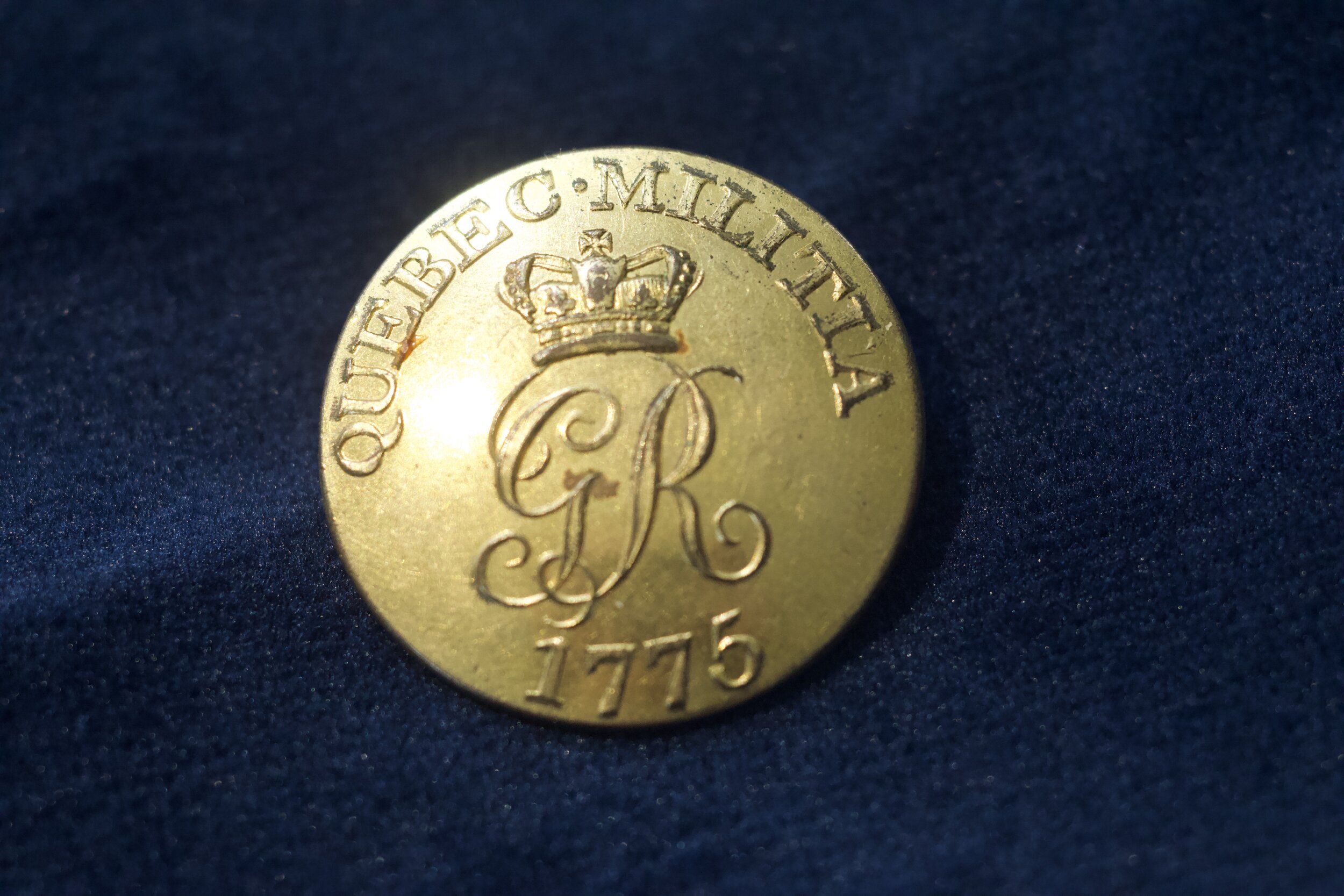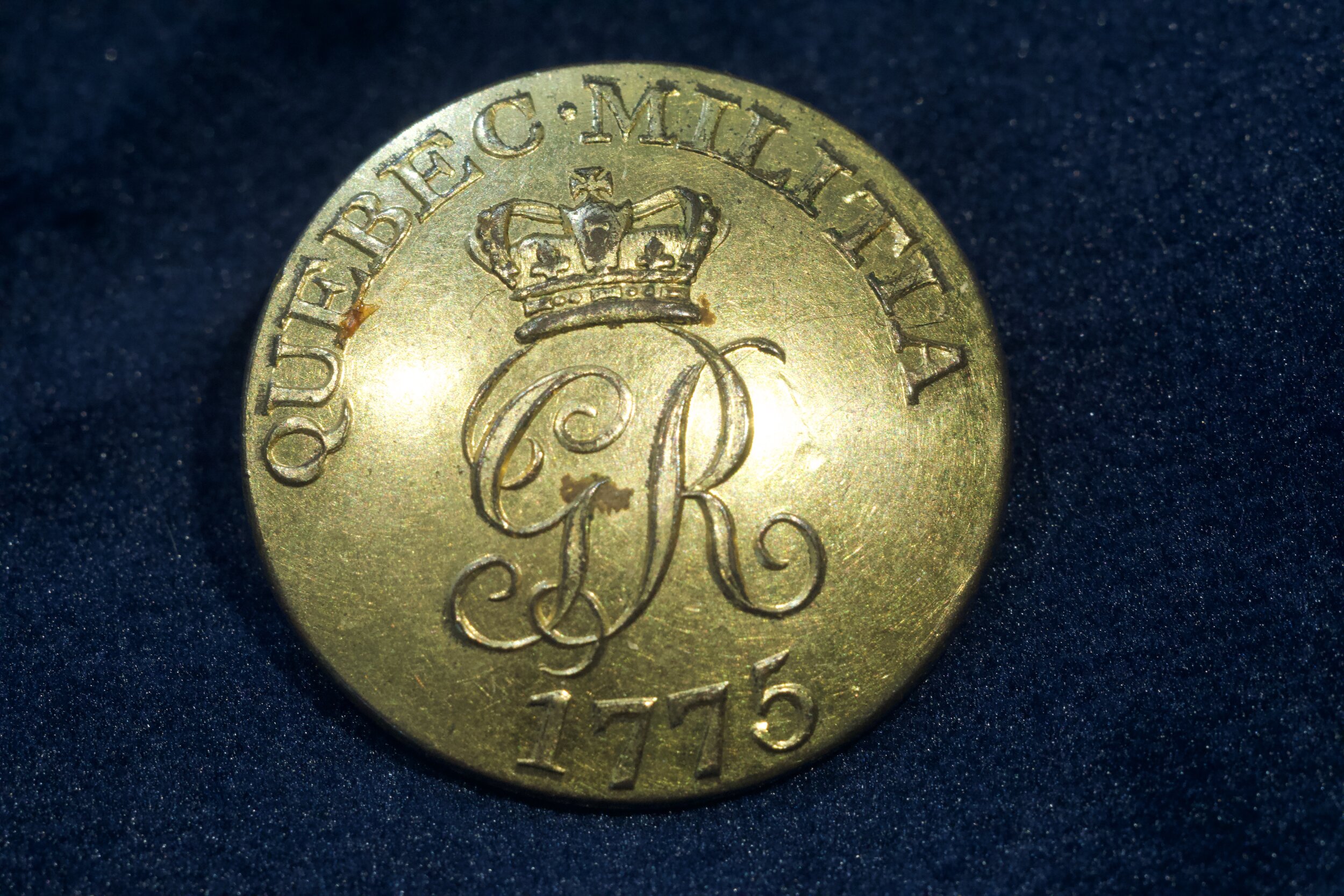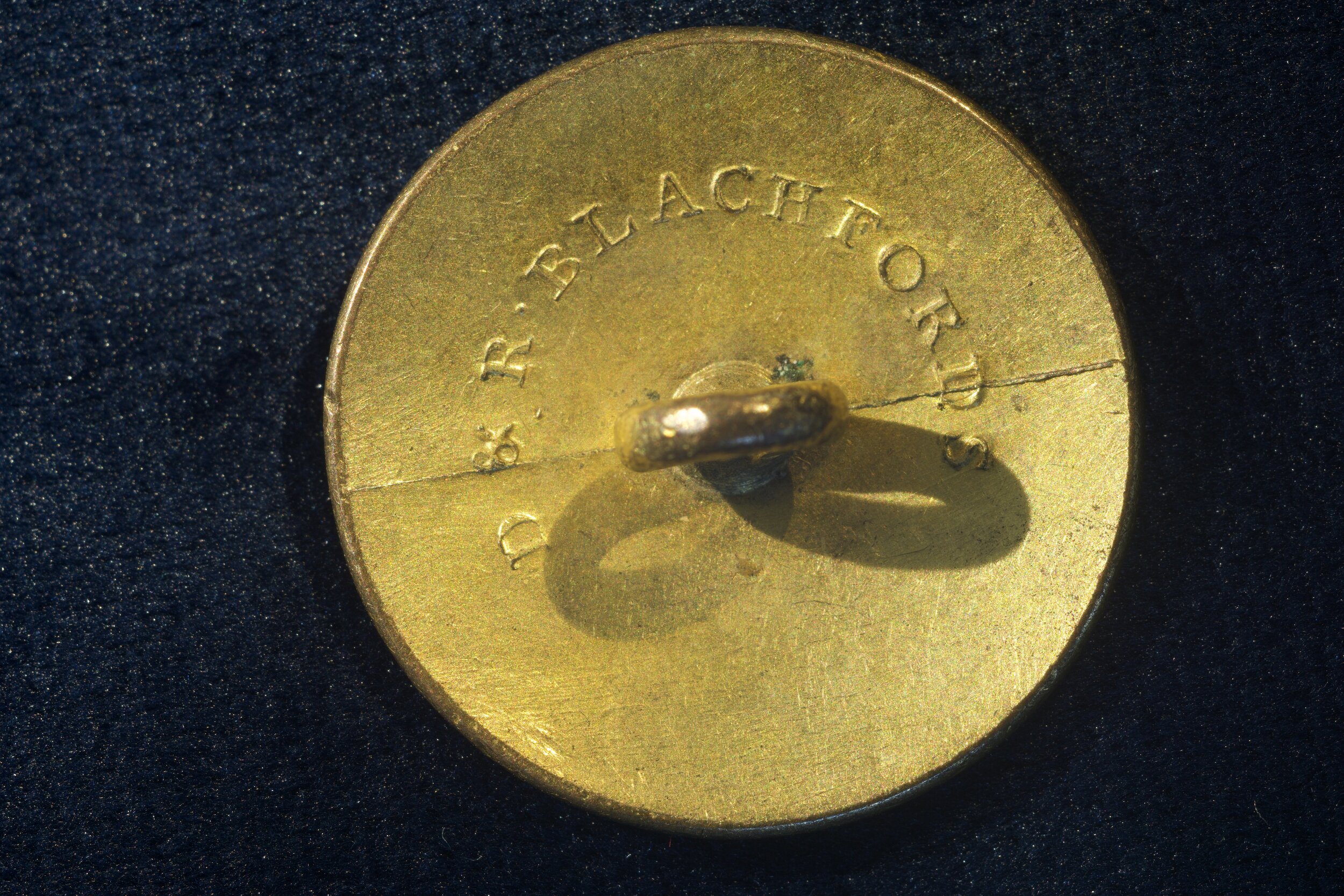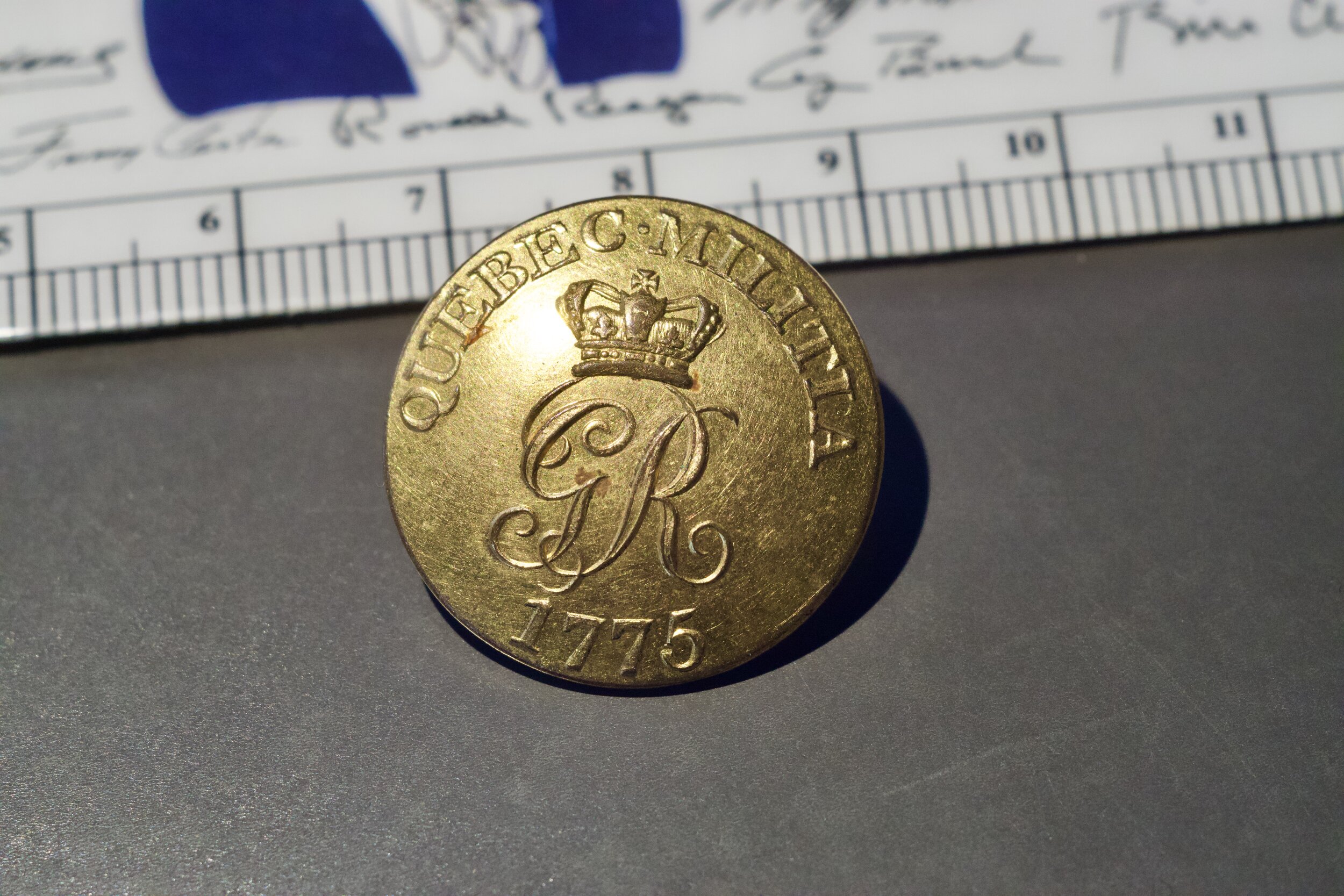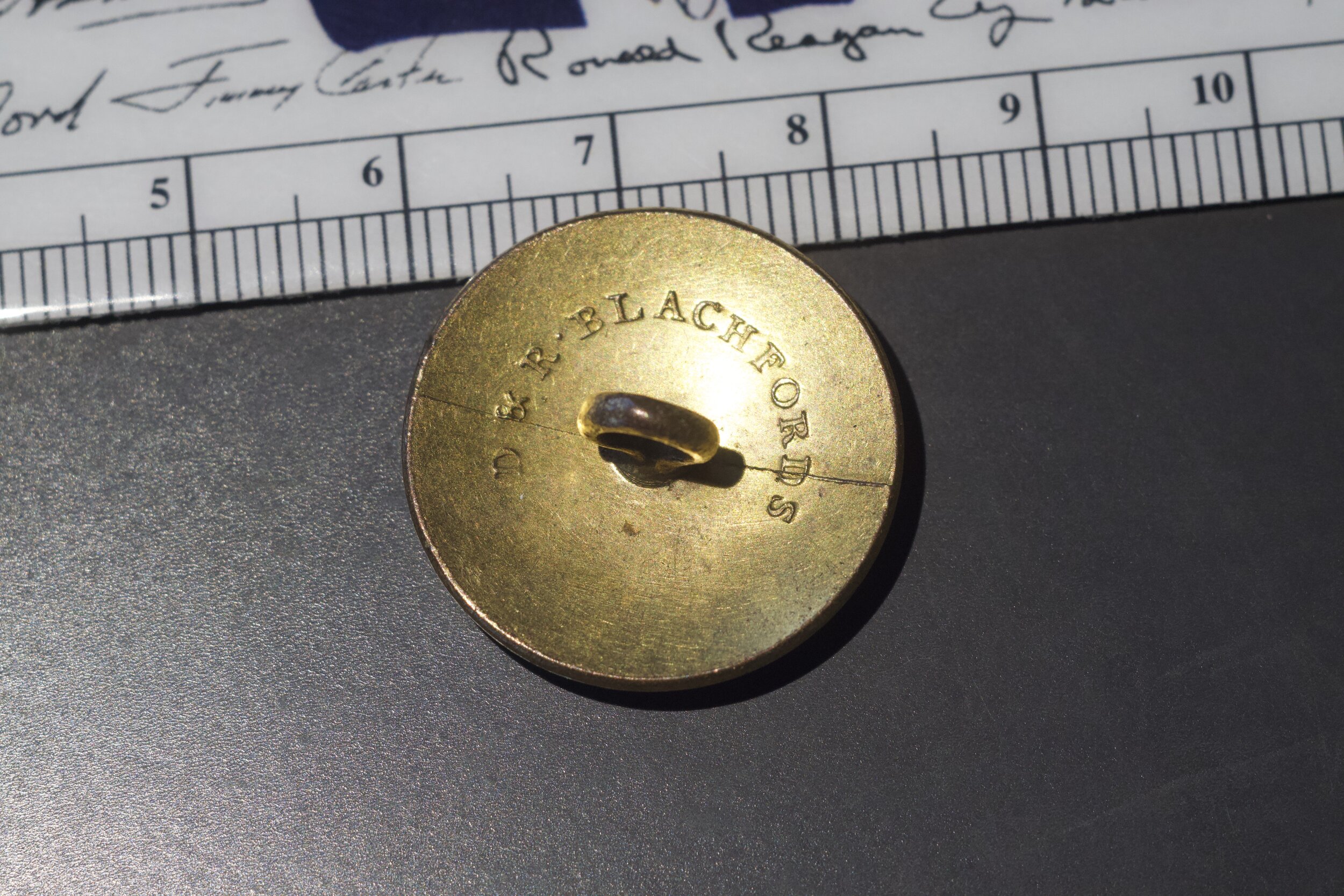Quebec Militia War of 1812 Gilt Officer's Uniform Button, MB-4.
Gilt brass. 23mm. Description provided by Alexander Noran of Norantyki.com:
The firm of Daniel & Richard Blachford has roots in the business of their father, David, who is recorded as early as at least 1772 as trading in gold, silver, and lace in Lombard Street, City of London. Although the sibling’s Lombard Street-based lace business is listed in the Gazette as going bankrupt in 1792, they are advertised in the same premises as gold and silver merchants in 1808, and as ‘gold and silver lacemen’ in an 1809 edition of the Monthly Magazine. Richard’s subsequent firm Richard Blachford & Co. was liquidated in 1814, further narrowing the range to 1809-13 – placing it firmly in the period of the War of 1812. Of note is that there is some indication of David serving as a contractor to the Royal Navy in and around this period.
This particular button is likely, owing to it being gilt brass rather than pewter or tin, to have originated from a uniform ordered from Daniel and Richard by an officer of the ‘British’ forces (the Quebec Militia was divided into Anglophone ‘British’ and Francophone ‘Canadien’ units). The crowned GR and date 1775 are symbols adopted by the Militia in reference to their valiant contributions to the defence of Quebec City against American invaders commanded by Arnold and Montgomery, with these motifs being formally adopted around 1803. René Chartrand notes that this particular style of button is generally found on coatees belonging to officers of the 3rd battalion, of which there is an example housed in the Canadian War Museum. Commenting on one such survivor, collections specialist Eric Fernberg places the date of manufacture at after 1805, also making note of the unit’s extensive defensive service during the War of 1812. Ultimately, the Quebec Militia would be disbanded in 1816.
The restrictive timeframe in which this button would have been in use not only allows us to glean a pretty precise date / use, it also goes toward explaining it’s incredible scarcity. The Chapman brothers, coin dealers in Philadelphia during the late 19th and early 20th centuries, used the term ‘extremely rare’ to describe their ‘fair, battened’ example, and the infrequency with which these come to market appears to have vindicated their assessment. When they are seen, most examples are either dug or heavily damaged, with some even flattened to circulate as coin in Montreal (Charlton MB-4). This example brilliantly lustrous, and in immaculate condition – an unmissable opportunity for the specialized button or token collector.
Gilt brass. 23mm. Description provided by Alexander Noran of Norantyki.com:
The firm of Daniel & Richard Blachford has roots in the business of their father, David, who is recorded as early as at least 1772 as trading in gold, silver, and lace in Lombard Street, City of London. Although the sibling’s Lombard Street-based lace business is listed in the Gazette as going bankrupt in 1792, they are advertised in the same premises as gold and silver merchants in 1808, and as ‘gold and silver lacemen’ in an 1809 edition of the Monthly Magazine. Richard’s subsequent firm Richard Blachford & Co. was liquidated in 1814, further narrowing the range to 1809-13 – placing it firmly in the period of the War of 1812. Of note is that there is some indication of David serving as a contractor to the Royal Navy in and around this period.
This particular button is likely, owing to it being gilt brass rather than pewter or tin, to have originated from a uniform ordered from Daniel and Richard by an officer of the ‘British’ forces (the Quebec Militia was divided into Anglophone ‘British’ and Francophone ‘Canadien’ units). The crowned GR and date 1775 are symbols adopted by the Militia in reference to their valiant contributions to the defence of Quebec City against American invaders commanded by Arnold and Montgomery, with these motifs being formally adopted around 1803. René Chartrand notes that this particular style of button is generally found on coatees belonging to officers of the 3rd battalion, of which there is an example housed in the Canadian War Museum. Commenting on one such survivor, collections specialist Eric Fernberg places the date of manufacture at after 1805, also making note of the unit’s extensive defensive service during the War of 1812. Ultimately, the Quebec Militia would be disbanded in 1816.
The restrictive timeframe in which this button would have been in use not only allows us to glean a pretty precise date / use, it also goes toward explaining it’s incredible scarcity. The Chapman brothers, coin dealers in Philadelphia during the late 19th and early 20th centuries, used the term ‘extremely rare’ to describe their ‘fair, battened’ example, and the infrequency with which these come to market appears to have vindicated their assessment. When they are seen, most examples are either dug or heavily damaged, with some even flattened to circulate as coin in Montreal (Charlton MB-4). This example brilliantly lustrous, and in immaculate condition – an unmissable opportunity for the specialized button or token collector.
Gilt brass. 23mm. Description provided by Alexander Noran of Norantyki.com:
The firm of Daniel & Richard Blachford has roots in the business of their father, David, who is recorded as early as at least 1772 as trading in gold, silver, and lace in Lombard Street, City of London. Although the sibling’s Lombard Street-based lace business is listed in the Gazette as going bankrupt in 1792, they are advertised in the same premises as gold and silver merchants in 1808, and as ‘gold and silver lacemen’ in an 1809 edition of the Monthly Magazine. Richard’s subsequent firm Richard Blachford & Co. was liquidated in 1814, further narrowing the range to 1809-13 – placing it firmly in the period of the War of 1812. Of note is that there is some indication of David serving as a contractor to the Royal Navy in and around this period.
This particular button is likely, owing to it being gilt brass rather than pewter or tin, to have originated from a uniform ordered from Daniel and Richard by an officer of the ‘British’ forces (the Quebec Militia was divided into Anglophone ‘British’ and Francophone ‘Canadien’ units). The crowned GR and date 1775 are symbols adopted by the Militia in reference to their valiant contributions to the defence of Quebec City against American invaders commanded by Arnold and Montgomery, with these motifs being formally adopted around 1803. René Chartrand notes that this particular style of button is generally found on coatees belonging to officers of the 3rd battalion, of which there is an example housed in the Canadian War Museum. Commenting on one such survivor, collections specialist Eric Fernberg places the date of manufacture at after 1805, also making note of the unit’s extensive defensive service during the War of 1812. Ultimately, the Quebec Militia would be disbanded in 1816.
The restrictive timeframe in which this button would have been in use not only allows us to glean a pretty precise date / use, it also goes toward explaining it’s incredible scarcity. The Chapman brothers, coin dealers in Philadelphia during the late 19th and early 20th centuries, used the term ‘extremely rare’ to describe their ‘fair, battened’ example, and the infrequency with which these come to market appears to have vindicated their assessment. When they are seen, most examples are either dug or heavily damaged, with some even flattened to circulate as coin in Montreal (Charlton MB-4). This example brilliantly lustrous, and in immaculate condition – an unmissable opportunity for the specialized button or token collector.


